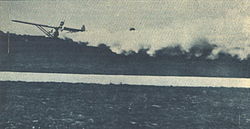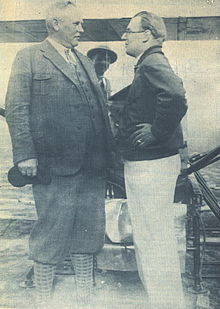- Opel RAK.1
-
The Opel RAK.1 (also known as the Opel RAK.3[1]) was the world's first purpose-built rocket-powered aircraft. It was designed and built by Julius Hatry under commission from Fritz von Opel who flew it on September 30, 1929 in front of a large crowd at Rebstock airport near Frankfurt-am-Main.
During the late 1920s, von Opel had undertaken a variety of publicity stunts involving rocket-powered vehicles, Opel-RAKs, for the Opel company. He was assisted in these endeavours by pyrotechnics manufacturer Friedrich Sander and rocketry advocate Max Valier. In June 1928, he had purchased an Alexander Lippisch-designed sailplane, the Ente, and fitted it with rockets. Opel did not get the chance to fly it, however, as the aircraft was destroyed by an engine explosion on its second test flight.
The RAK.1 had a typical sailplane wing, under which a pod was suspended to accommodate the pilot and sixteen solid rocket engines. The tailplane was mounted on booms behind the wing and high out of the way of the rocket exhaust. Opel successfully piloted it over 1.5 km (0.93 mi) in 75 seconds of flight, but landed hard, damaging the aircraft beyond repair. Opel planned to build a second rocket plane, but apparently lost interest before the project was completed.
The aircraft is sometimes referred to as the Opel-Hatry RAK.1 or Opel-Sander RAK.1 in acknowledgment of its builder or the supplier of its engines respectively. In still other references it is called the RAK.3 to distinguish it from Opel's previous RAK.1 and RAK.2 rocket cars. As it happened, all three names, Opel, Sander, and Hatry were painted on the aircraft (with Opel’s most prominent), as was the RAK.1 designation.
Specifications (RAK-1)
Data from {name of first source}
General characteristics
- Crew: one, pilot
- Length: m (ft in)
- Wingspan: m (ft in)
- Height: m (ft in)
- Wing area: m (ft)
- Empty weight: kg (lb)
- Loaded weight: kg (lb)
- Useful load: kg (kg)
- Max takeoff weight: kg (lb)
Performance
- Never exceed speed: km/h (knots, mph)
- Maximum speed: 150 km/h (knots, 93 mph)
- Cruise speed: km/h (knots, mph)
- Stall speed: km/h (knots, mph)
- Range: 1.5 km (nm, 4,900 ft)
- Service ceiling: m (ft)
- Rate of climb: m/s (ft/min)
- Wing loading: kg/m² (lb/ft²)
References
Opel Current Opel
passenger carsCurrent Opel
commercial vehiclesHistoric and
discontinued modelsAdmiral • Arena • Ascona • Bedford Blitz • Blitz • Calibra • Campo • Chevette • Commodore • Diplomat • 5/12 PS "Puppchen" • 4/8 PS "Doktorwagen" • Frontera • GT • Kadett • Kapitän • Laubfrosch • Manta • Monterey • Monza • Olympia • Omega • Patentmotorwagen „System Lutzmann“ • P4 • RAK • RAK1 • RAK2 • Regent • Rekord • Senator • Signum • Sintra • Speedster • Super 6 • Tigra • 10/30 (10/35) PS • 12,3-Liter-Rennwagen • VectraMotor racing cars Concept cars Divisions and
subsidiariesOpel Eisenach GmbH • Opel Motoren Kaiserslautern GmbH • Opel Powertrain GmbH • Opel Performance Center GmbH • Opel Special Vehicles GmbHOther Lists relating to aviation General Aircraft (manufacturers) · Aircraft engines (manufacturers) · Airlines (defunct) · Airports · Civil authorities · Museums · Registration prefixes · Rotorcraft (manufacturers) · TimelineMilitary Accidents/incidents Records Categories:- German experimental aircraft 1920–1929
- Rocket-powered aircraft
- Gliders
- Opel vehicles
Wikimedia Foundation. 2010.


